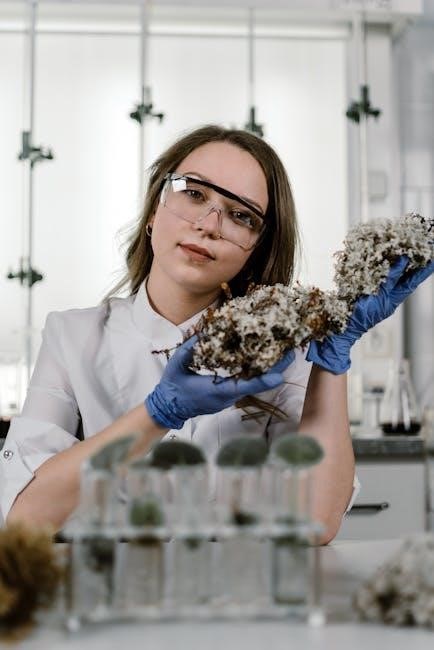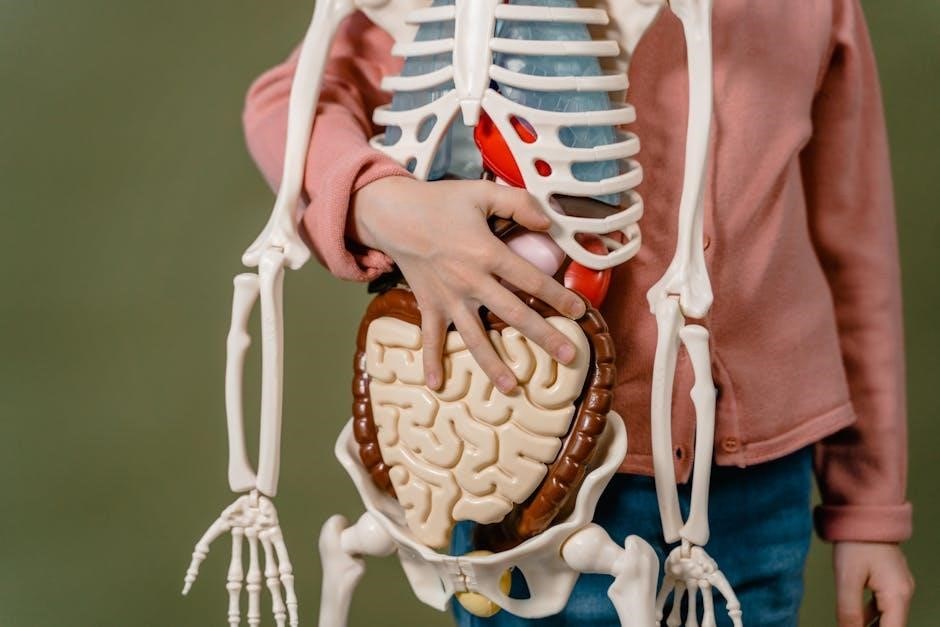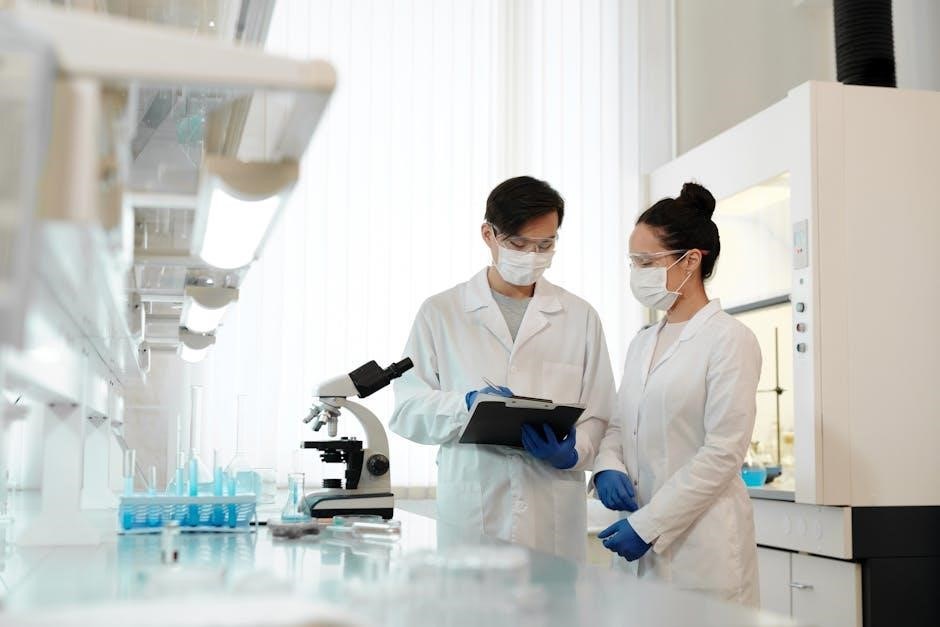Characteristics of Life
Living organisms exhibit traits like reproduction, growth, and homeostasis, enabling them to maintain stability and respond to stimuli while obtaining and utilizing energy for survival․
1․1․ Key Features of Living Organisms
Living organisms exhibit essential traits such as reproduction, growth, and development․ They maintain homeostasis, respond to stimuli, and require energy to sustain life․ All life forms are composed of matter, primarily oxygen, carbon, hydrogen, and nitrogen․ Biological molecules like carbohydrates, lipids, proteins, and nucleic acids are fundamental․ Organisms also exhibit organization, from cells to complex systems, and demonstrate adaptation through evolution․ These features collectively define life and enable organisms to interact with their environment and perpetuate their species․
1․2․ Homeostasis and Its Importance
Homeostasis is the ability of organisms to maintain internal stability despite external changes․ It ensures optimal conditions for cellular functions, enabling proper metabolism, enzyme activity, and overall health․ Regulatory mechanisms, such as feedback loops, allow organisms to adjust to environmental shifts․ This balance is crucial for survival, as disruptions can lead to disease or death․ Homeostasis exemplifies the complexity of life, highlighting how organisms sustain vital processes to thrive in dynamic environments․

Cell Structure and Function
Cells are the basic structural and functional units of life, with prokaryotic and eukaryotic types differing in complexity․ Key organelles include the nucleus, mitochondria, and ribosomes․
2․1․ Prokaryotic vs․ Eukaryotic Cells
Prokaryotic cells lack a nucleus and membrane-bound organelles, with a single circular chromosome․ Eukaryotic cells have a nucleus, membrane-bound organelles, and linear chromosomes․ Prokaryotes are smaller and simpler, while eukaryotes are larger and more complex, enabling specialized functions․ Key differences include cell size, complexity, and the presence of a true nucleus․ Examples of prokaryotes include bacteria, while eukaryotes encompass plants, animals, fungi, and protists․ These distinctions fundamentally classify life, influencing metabolic processes and cellular organization․
2․2․ Major Organelles and Their Functions
The nucleus houses genetic material, controlling cell activities․ Mitochondria produce energy via ATP synthesis․ The endoplasmic reticulum synthesizes proteins (rough) and lipids (smooth)․ The Golgi apparatus modifies and transports proteins․ Lysosomes digest cellular waste, while ribosomes synthesize proteins․ The cell membrane regulates substance entry and exit, maintaining cellular integrity․ Each organelle performs specialized roles, ensuring proper cellular function and overall organism survival․
Biological Molecules
Essential biomolecules include carbohydrates, lipids, proteins, and nucleic acids, each serving unique roles in energy storage, structural support, and genetic information storage and transmission․
3․1․ Essential Biomolecules: Carbohydrates, Lipids, Proteins, Nucleic Acids
Carbohydrates, such as sugars and starches, primarily serve as energy sources․ Lipids, including fats and oils, store energy and maintain cell membrane structure․ Proteins, made of amino acids, perform diverse functions like catalysis and transport․ Nucleic acids, DNA and RNA, store and transmit genetic information․ These biomolecules are vital for life, each contributing uniquely to cellular processes and overall organism function, ensuring proper growth, reproduction, and energy utilization․
3․2․ Role of Water in Biological Systems
Water is essential for life, acting as a universal solvent, transporting nutrients, and regulating temperature through evaporation․ It maintains cellular structure and facilitates metabolic processes․ Water is a reactant in photosynthesis and digestion, aiding energy production․ Its polarity allows it to dissolve salts and minerals, enabling nutrient uptake and waste removal․ Homeostasis relies on water balance, and its high surface tension supports cellular integrity․ Water’s chemical properties make it indispensable for sustaining life and biological functions at all levels․

Photosynthesis and Cellular Respiration
Photosynthesis and respiration are vital processes converting energy, with photosynthesis producing ATP from light and respiration breaking down glucose to release energy, sustaining life․
4․1․ Stages of Photosynthesis and Its Importance
Photosynthesis occurs in two stages: the light-dependent reactions and the Calvin Cycle․ Light reactions in the thylakoid membranes capture sunlight, producing ATP and NADPH․ The Calvin Cycle uses these molecules to fix CO₂ into glucose in the stroma․ Photosynthesis is vital for producing oxygen and serving as the primary energy source for ecosystems, sustaining life by converting light energy into chemical energy and regulating Earth’s climate through carbon sequestration․ Understanding these processes is essential for comprehending energy flow and nutrient cycling in biological systems․ This knowledge is fundamental for biology students preparing for exams․
4․2․ Aerobic and Anaerobic Respiration Processes
Aerobic respiration requires oxygen and occurs in mitochondria, producing 36-38 ATP per glucose molecule through the citric acid cycle and electron transport chain․ Anaerobic respiration lacks oxygen, occurring in the cytoplasm, and yields 2 ATP per glucose, with byproducts like lactate or ethanol․ Both processes break down glucose to generate energy, but aerobic respiration is more efficient․ Understanding these pathways is crucial for biology exams, as they explain how cells produce energy and sustain life under varying oxygen conditions, highlighting cellular metabolism’s adaptability․

Genetics and Heredity
Genetics explores how traits are inherited through Mendel’s laws, Punnett squares, and DNA structure․ It explains genotype-phenotype relationships and heredity patterns across generations, essential for understanding biological diversity․
5․1․ Mendel’s Laws of Inheritance
Mendel’s laws form the foundation of genetics, describing how traits are inherited․ The Law of Segregation states that alleles separate during gamete formation, while the Law of Independent Assortment explains that different traits segregate independently․ The Law of Dominance clarifies that dominant alleles mask recessive ones in heterozygotes․ These principles, discovered through pea plant experiments, are visualized using Punnett squares, which predict genetic outcomes․ Understanding these laws is crucial for analyzing inheritance patterns, genotype-phenotype relationships, and their role in modern genetic studies and heredity predictions․
5․2․ Punnett Squares and Predicting Genetic Outcomes
Punnett squares are tools used to predict genetic outcomes of crosses, illustrating the probability of offspring traits․ They combine alleles from parents to show genotype ratios․ For example, a Dd x Dd cross results in 75% dominant (DD, Dd) and 25% recessive (dd) offspring․ This method helps determine phenotypic and genotypic probabilities, aiding in understanding inheritance patterns․ Punnett squares are essential for analyzing monohybrid and dihybrid crosses, providing clear, visual representations of genetic diversity and aiding in predicting trait distribution in future generations․

Ecological Concepts
Ecological concepts explore interactions between organisms and their environment, focusing on energy flow, nutrient cycling, and the structure of ecosystems, from cells to biomes․
6․1․ Levels of Organization: From Cells to Ecosystems
The levels of organization in biology range from the simplest to the most complex, starting with cells, tissues, organs, organ systems, organisms, populations, communities, ecosystems, biomes, and finally, the biosphere․ Each level builds on the previous one, forming a hierarchical structure that describes how life is organized․ Understanding these levels helps in studying interactions within biological systems and how they function collectively to maintain balance and support life on Earth․
- Cell: Basic structural and functional unit of life․
- Tissue: Group of similar cells performing specific functions․
- Organ: Structure composed of two or more tissues․
- Organ System: Multiple organs working together․
- Organism: Individual living being․
- Population: Group of the same species in a specific area․
- Community: All populations in an area․
- Ecosystem: Community plus its physical environment․
- Biome: Large ecosystem type (e․g․, desert, forest)․
- Biosphere: Global sum of all ecosystems․
6․2․ Energy Flow and Nutrient Cycling in Ecosystems
Energy flows through ecosystems in a unidirectional manner, primarily through food chains and webs, with only 10% of energy transferred between trophic levels․ Nutrient cycling involves the continuous movement of nutrients like carbon, nitrogen, and water through biotic and abiotic components․ Decomposition by microorganisms returns nutrients to the environment, sustaining life․ These processes maintain ecosystem balance and ensure resources are available for future generations․
- Energy flow: Producers to consumers via food chains․
- Nutrient cycling: Reuse of nutrients through decomposition․
- Key cycles: Carbon, nitrogen, and water cycles․
- Decomposition: Breaks down organic matter, releasing nutrients․

Scientific Method and Biological Systems
The scientific method provides a systematic approach to investigating biological systems, emphasizing observation, hypothesis, experimentation, and conclusion to understand life’s complexity and organization․
7․1․ Steps of the Scientific Method
The scientific method involves systematic steps: observation to identify phenomena, forming a question, researching, hypothesizing, experimenting to test the hypothesis, analyzing data, drawing conclusions, and communicating results․ This structured approach ensures unbiased and reproducible investigations in biology, fostering understanding and advancing knowledge․ Each step builds on the previous one, providing a clear framework for addressing complex biological questions and ensuring the validity of findings․
7․2․ Hierarchical Structure of Biological Systems
Biological systems are organized hierarchically, starting from atoms forming molecules, which compose cells; Cells create tissues, tissues form organs, and organs function as systems within organisms․ Organisms interact in populations, forming communities within ecosystems, which are part of biomes and ultimately the biosphere․ This layered structure ensures complexity and functional specialization, allowing life to thrive at every level, from molecular interactions to global environmental systems, illustrating the integrated nature of biological organization․
